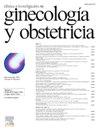Impact of deep endometriosis with and without ovarian involvement on quality of life compared to exclusive ovarian endometriosis
IF 0.1
Q4 OBSTETRICS & GYNECOLOGY
Clinica e Investigacion en Ginecologia y Obstetricia
Pub Date : 2025-05-10
DOI:10.1016/j.gine.2025.101053
引用次数: 0
Abstract
Objective
To evaluate potential differences in quality of life between patients with deep endometriosis, with or without ovarian involvement (DE), and those with exclusive ovarian endometriosis (OMA).
Material and method
A prospective observational study was conducted on patients diagnosed with endometriosis through clinical assessment and imaging techniques, or histological confirmation. Patients were labeled as OMA or DE. Clinical data such as pain (visual analogue scale), demographic and anthropometric data, and QoL (SF-12v2 scale) were evaluated. Statistical analysis was performed using IBM SPSS 25.0.
Results
A total of 307 patients were enrolled, 109 with OMA and 198 with DE. Patients with OMA were younger than those with DE. QoL in the physical domain was lower in DE compared to OMA (46 ± 11.91 vs 49.9 ± 9.4; p < 0.02). No statistically significant differences were observed in the mental domain (41.5 ± 10.2 vs 42.8 ± 11; p < 0.276). Pain scores on the visual analogue scale did not differ significantly between groups. However, in the pain domain of the SF-12v2 scale, significant differences were found, with lower scores in DE (61.4 ± 32.7 vs 73.6 ± 28.6; p < 0.001).
Conclusion
QoL scales should be utilized in clinical practice as they provide valuable insights into how the disease impacts patients’ lives. Patients with deep endometriosis have a poorer QoL in the physical domain compared to those with exclusive ovarian endometriosis.
与排他性卵巢子宫内膜异位症相比,伴有和不伴有卵巢受累的深部子宫内膜异位症对生活质量的影响
目的评价深部子宫内膜异位症伴或不伴卵巢受累(DE)患者与排他性卵巢子宫内膜异位症(OMA)患者生活质量的潜在差异。材料与方法对经临床评估、影像学检查或组织学证实的子宫内膜异位症患者进行前瞻性观察研究。将患者标记为OMA或DE。评估临床数据,如疼痛(视觉模拟量表)、人口统计学和人体测量数据以及生活质量(SF-12v2量表)。采用IBM SPSS 25.0进行统计学分析。结果共纳入307例患者,其中OMA患者109例,DE患者198例,OMA患者年龄小于DE患者,DE患者的生理生活质量低于OMA患者(46±11.91 vs 49.9±9.4;p & lt;0.02)。两组在心理领域的差异无统计学意义(41.5±10.2 vs 42.8±11;p & lt;0.276)。视觉模拟量表疼痛评分组间无显著差异。然而,在SF-12v2量表的疼痛域,发现有显著差异,DE得分较低(61.4±32.7 vs 73.6±28.6;p & lt;0.001)。结论生活质量量表对疾病如何影响患者生活提供了有价值的见解,值得在临床实践中使用。与排他性卵巢子宫内膜异位症患者相比,深部子宫内膜异位症患者在物理领域的生活质量较差。
本文章由计算机程序翻译,如有差异,请以英文原文为准。
求助全文
约1分钟内获得全文
求助全文
来源期刊

Clinica e Investigacion en Ginecologia y Obstetricia
OBSTETRICS & GYNECOLOGY-
CiteScore
0.20
自引率
0.00%
发文量
54
期刊介绍:
Una excelente publicación para mantenerse al día en los temas de máximo interés de la ginecología de vanguardia. Resulta idónea tanto para el especialista en ginecología, como en obstetricia o en pediatría, y está presente en los más prestigiosos índices de referencia en medicina.
 求助内容:
求助内容: 应助结果提醒方式:
应助结果提醒方式:


